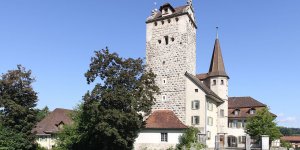| Travel / Tourist Attractions |
St. Paul's Church (Sint-Pauluskerk), Antwerp, Belgium
The St. Paul's Church is located in the old city center of Antwerp, just a few steps from the Scheldt river, in a district where formerly sailors used to live. A small church was built here by the Dominican Order and consecrated in 1276 by Albertus Magnus. The church is named after the patron saint of the Dominicans, St. Paul.
The exterior is mainly executed in the Brabantine Gothic style and is characterized by the austere architecture with little exterior decoration, which is common in churches of mendicant orders. For the interior walls brick was used, while the outer vestments and structural components are in Ledian sandstone.
The tower was rebuilt in the late 17th century with a Baroque top. The baroque portal on the angled corner of Veemarkt and Zwartzustersstraat dates from 1734. In the arch above the gate is a tympanum sculpture by Jan Claudius de Cock of 1734 depicting Our Lady of the Rosary giving the rosary to Saint Dominic and Catherine of Siena, the reformer of the Dominican Order.
The columns in St. Paul's Church are cylindrical and are topped by a capital with cabbage leaf motif. The interior decoration is a good example of the Flemish Baroque style in painting as well as church furniture.

Interior of Sint-Pauluskerk, Antwerp. ![]()
Among the many works of art in the church are works by major artists such as the Antwerp painters Peter Paul Rubens, Anthony van Dyck, Jacob Jordaens, Cornelis de Vos, Gaspar de Crayer, Frans Francken II, Abraham van Diepenbeeck, Theodoor Boeyermans, Artus de Bruyn, Arnout Vinckenborch and Matthys Voet.
The St. Paul's Church holds the most impressive array of Baroque confessionals in Belgium. The 10 confessionals, executed around 1659 by Pieter Verbrugghen I with the assistance of his workshop and other sculptors, are divided in groups of five on the side of both aisles. Each confessional is flanked by two statues on either side.

Interior of Sint-Pauluskerk, Antwerp. ![]()
The confessionals are not conceived as separate pieces of furniture but are connected by a wooden paneling. The entire wall of each aisle is thus turned into a single united piece of furniture, the iconography of which strives to achieve the same unity and synthesis as the whole structure.
On the south side is the Chapel of the Holy Sacrament and of the Sweet Name Jezus which has an altar sculpted by Pieter Verbrugghen I and an altar piece by Rubens on The Disputation of the Holy Sacrament. This chapel also holds a Baroque confessional by Willem Kerricx the Elder that was originally placed on the north side of the main entrance.

Peter Paul Rubens - The Disputation of the Holy Sacrament. ![]()
On the north side is the Maria Chapel with a Baroque altar which was commenced by Huybrecht Van den Eynde, continued by his pupil Sebastiaan de Neve and completed by Jan Pieter van Baurscheit de Elder in 1728.
A typical rubensian motif are the dozens of miniature putti and cherubs on the ascending branches of vegetal, Marian symbols on the twisted marble columns. The painting Adoration of the shepherds by Rubens forms the altar piece. The Maria Chapel also contains a white marble sculpture of Our Lady of Sorrows by Jan Pieter van Baurscheit de Elder.
The church holds elaborate tomb monuments attributed to Johannes van Mildert, Pieter Verbrugghen II and Andries Colyns de Nole.
The 17th century organ is regarded as one of the most important organs of Belgium. The monumental organ case was sculpted by Pieter Verbrugghen I after a design by Erasmus Quellinus II.
On the outside of the church is a group of statues referred to as the Calvary. It was created on the location of an ancient Dominican cemetery by the brothers van Ketwigh who were Dominican friars. Its design dates from 1697.
In 1734 construction of the Calvary was completed but further statues were added up to 1747. It is built as a courtyard and leans on one side against the south aisle of the church and the Chapel of the Holy Sacrament.
The structure includes 63 life-size statues and nine reliefs executed in a popular and theatrical style. Most statues are of white stone with some made of wood.
The statues are arranged into four groups: the angel path, which ascends to the Holy Sepulchre, the garden of the prophets on the left, the garden of the evangelists on the right and the Calvary itself, which consists of an elevated artificial rock, divided into three terraces, on which statues are placed with Christ on the cross at the top. (Wikipedia)
YOU MAY ALSO LIKE








